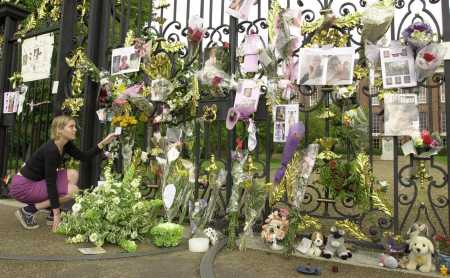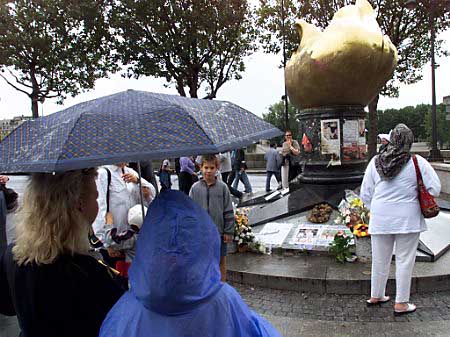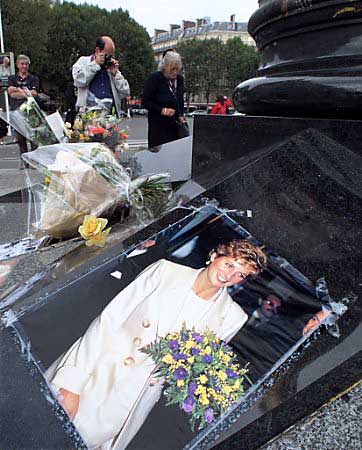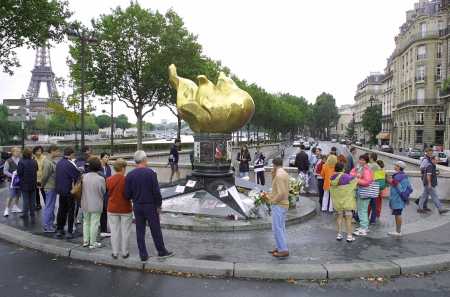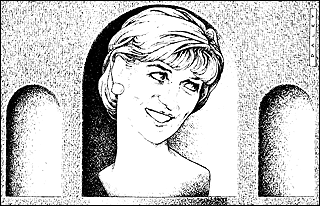

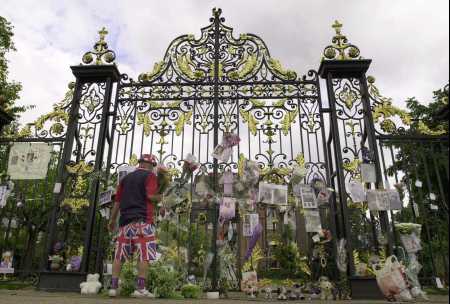
|
Princes mark Diana's death privately The fourth anniversary of the death of Princess Diana is being marked privately by her sons William and Harry. The teenage princes and Prince Charles will remember her in their own way, said St James's Palace. Charles is finishing his autumn holiday at Birkhall on the Balmoral estates in Scotland, and William is understood to be in Scotland too. As in the two previous years, there are no official plans to commemorate the day Diana died in a Paris car crash in 1997. But Harrods owner Mohamed Al Fayed, whose son Dodi was killed with her, has chosen to mark the anniversary by continuing his battle to prove their deaths were no accident. Mr Al Fayed put together a video presentation for the press in Washington, US, saying he was in no doubt that the deaths were a result of murder with racism at the core and setting out his allegations in more detail. Although many of his arguments had been aired before, he said Diana's body had been embalmed within hours of her death and said this was to prevent proper forensic tests in Britain. He also repeated allegations that the Mercedes driver Henri Paul - blamed by a French magistrate for being drunk and causing the accident - had ties to British intelligence. Former British agent Richard Tomlinson, whose book about the intelligence service was blocked in the UK, was used to support Mr Al Fayed's allegations in the video. French investigators long ago concluded that Mr Paul had no ties to British or any other intelligence agency. Although there is no official commemoration of Diana's death, individual events are taking place around Britain. Friday 31st August 2001 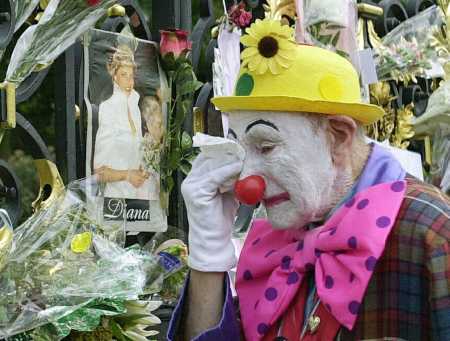
Tributes have been paid to Princess Diana as people gather to lay flowers at her former home. People have been leaving floral tributes, soft toys and poems at Kensington Palace. The fourth anniversary of the death of Princess Diana is being marked privately by her sons William and Harry. A ring of tiny candles lined the base of the palace gates and one message read 'Dearest Diana wishing your sweetest dreams will continue'. Edward Larkin, 81, dressed in a large tartan coat and with his face painted, wept as he looked at the bouquets and messages tied to the gates of Kensington Palace in central London.
Retired Mr Larkin from Tooting, south London, who devotes his spare time to raising funds for various charities as Garibaldi the clown, has marked every anniversary of Diana's death by leaving flowers at the palace. He said: "I've come in costume because this is how she knew me. I met her when she came to visit a hospital close to where I live. "I had a bunch a flowers for her and was dressed up and cracking jokes for the crowd. When she came out she said hello and I gave her the flowers, she was so warm and genuine."
Julie Cain, 37, from Newcastle upon Tyne, who has also laid flowers at Kensington Palace at previous anniversaries said: "The hierarchy want people to forget her which is something that's not going to happen. We will not let her memory be forgotten." Another fan, John Loughrey, 46, a chef from Wandsworth, said: "She was like a queen in her own terms and she will always be a queen and will be remembered a thousand years from now." Friday 31st August 2001
Thursday August 30 1:49 PM ET Princess Diana Remains in the NewsBy AUDREY WOODS, Associated Press WriterLONDON (AP) - It has been four years since Princess Diana died in a Paris car crash, yet she is never very far from the news, and her image still graces the nation's newspapers at every opportunity. In the days before Friday's anniversary, headlines enticed readers to stories that might just offer a tidbit of old gossip - ``Secrets Diana Told Me'' - or shed some light on her relationship with her mother - ``Missing My Diana.'' It hardly seems to matter that the secrets are no surprise and that Diana's mother, Frances Shand Kydd, is writing about her grief and not about her daughter. Even the posthumous disappearance of Diana's handbags and old pop CDs is enough to make the front pages. The arrest of Diana's trusted butler and confidant Paul Burrell, charged Aug. 16 with stealing hundreds of personal items of the princess and members of the royal family, riveted readers around the country and abroad. Burrell denies the charges and says he never betrayed the princess. A sober and meaningful commemoration of the princess's life was left to the Diana, Princess of Wales Memorial Fund, which this week announced a $7.2 million project to educate health workers in Africa and help ease the suffering of Africans dying of AIDS and other diseases. The fund, set up days after Diana's death Aug. 31, 1997, has pledged nearly $65 million to charities this year. Diana's sister, Lady Sarah McCorquodale, is president of the fund, which receives donations and profits from the sale of approved mementos. As before, the royal family will keep its feelings and its observances private, well outside the public domain where so much of the princess's life was lived. Prince Charles' office at St. James's Palace says he will still be in Scotland, where Queen Elizabeth II and most of her family spend the month of August at Balmoral Castle. The plans of Prince William and Prince Harry are not being revealed, but 19-year-old William is likely to be preparing for his first year of art studies at the University of St. Andrews in eastern Scotland. Prince Harry, a strapping 16-year-old, has been photographed at polo games in the company of a gaggle of teen-age girls but otherwise keeps a low profile. Prince Charles has brought Camilla Parker Bowles out of the shadows of his life, without noticeably adverse effect. A recent opinion poll for The Guardian newspaper suggested public acceptance of the match is growing. The poll, with a margin of error of 3 percentage points, found that 43 percent of those asked said the couple should wed, and 32 percent said they should not. In August 1998, a year after Diana's death, 46 percent of Britons said they opposed a second marriage for Charles, and only 35 percent approved. Even Diana's brother, Earl Spencer, said last month he had ``nothing against'' Charles and that any future marriage was ``none of my business.'' At the same time he acknowledged that concerns about the upbringing of the young princes, which he had expressed in his widely publicized funeral eulogy for his sister, had been unfounded. ``The two boys have their heads screwed on very well,'' he told London radio LBC. ``I think it's all been fine and they are incredibly well balanced.'' For Mohamed Al Fayed, father of Diana's companion in the fatal car crash, Dodi Fayed, the battle to prove their deaths were no accident continues into its fifth year. Al Fayed, Egyptian-born owner of Harrods department store, put together a video presentation for the press in Washington on Thursday, saying he was ``in no doubt that the deaths were a result of murder with racism at the core'' and setting out his allegations in more detail. Much old ground was covered, but he added that Diana's body had been embalmed within hours of her death and that this was to prevent proper forensic tests in Britain. A French magistrate's investigation blamed the accident on driver Henri Paul, saying he was drunk. Al Fayed has alleged - and repeated Thursday - that the driver, who also died, had ties to British intelligence. Former British agent Richard Tomlinson, whose book about the intelligence service was blocked in Britain, supported Al Fayed's allegations in a video presentations. But French investigators long ago concluded that Henri Paul had no ties to British or any other intelligence agency. From
the Daily Telegraph
By Harry Mount AT the entrance to the Diana, Princess of Wales Memorial Playground in Kensington Gardens, there's a large sign that describes its purpose. "The facilities provided are designed to comply with European and British legislation. However, it is now recognised that risk-taking is an important element of play and physical development. Parents and carers must note that the design of this playground does allow for a degree of risk. This is provided so that your child can develop an appreciation of risk in a controlled play environment rather than taking similar risks in the unregulated wider world." Useful as all this might be, nothing in the playground will protect a child from the real dangers of life. However long you spend in Beach Cove or the Mermaid's Fountain, it will not be much of a preparation for, say, the perils of being driven through Paris at high speed by a drunken chauffeur or contracting an unsuitable marriage to a prince 13 years your senior. Even if the playground is no training ground for the miseries of adulthood, it is certainly well-appointed. At the heart of the Peter Pan-inspired site is a fine pirate ship, costing £150,000, trimmed with rigging, beached in sand and flanked by an imposing crocodile and a treasure chest. A flock of fake sheep graze contentedly about the place and there are several substantial wigwams that look as if they would withstand the attentions of the bloodthirstiest cowboy - or three-year-old child. But, however impressive the playground is, it is still a playground. It hardly compares with the great monuments to members of the Royal Family: the Albert Memorial, the Victoria Memorial, Queen Victoria's Mausoleum at Frogmore, the royal tombs at Westminster Abbey and St George's Chapel, Windsor, the statues that line Trafalgar Square and the Mall, and stand in a thousand market squares across the country. Most of the principal dead members of the Royal Family over the past centuries have London statues. Not a few minor royal figures have also been modelled - Lord Mountbatten next to Downing Street, a 19th-century Duke of Kent by Regent's Park. Whatever you might have thought of the Princess, her importance as a social figure at the end of the 20th century was remarkable. Her importance as a historical figure deserves recognition. Two separate organisations were set up after the Princess's death to spend the money collected in her name. One, the Diana, Princess of Wales Memorial Fund, gives support to charities with a different theme each year: for 2000-01, the fund will help "communities affected by landmines, cluster bombs and other forms of unexploded ordinance" and will assist with "the rehabilitation and reintegration of the most disadvantaged people post-conflict, particularly those who face prejudice from their own communities". A few of the charities are controversial: the £243,000 for the Ulster Quaker Service Committee, for "work with young people with a close family member in prison, using arts, photography and drama", or the £22,000 for the Healthy Gay Living Centre, to "design and produce a CD-Rom for young lesbian and bisexual women, and those working with them. To reduce their isolation and promote positive mental health." Most of the charities, though, are admirable, with an emphasis on landmine victims, refugees, orphans and battered women. This week, £5 million has been given to Aids charities. Still, none of these charities could hope to act as memorials that will in a century's time show what the Princess actually looked like and tell a little of what she did - things that a statue and an inscription do rather well. The other body set up after her death - the Diana, Princess of Wales Memorial Committee - has a brief to come up with more personal mementos, but has not done much better than the fund. So far it has produced the playground, the Memorial Walk - through Kensington Gardens, Hyde Park, Green Park and St James's Park - a commemorative £5 coin, a specialised group of children's nursing teams and a memorial award for brave children. A fountain will be built in Hyde Park, but it has been decided that it will not include any representation of the Princess. "Both the Royal Family and the Spencer family felt they'd prefer not to have any lifelike monument," says a committee spokesman. This is all very well, but hardly likely to keep her memory alive for generations yet unborn. A decade after she fell from power, Margaret Thatcher is already a closed book to most people under the age of 20. What chance of being remembered does the Princess stand? Who, on strolling along her Memorial Walk in the year 2101, will take notice of the metal discs - with a brief inscription and a small rose - that have been set into the tarmac at strategic points around London? That the Royal Family or the Spencers - and, by implication, the fund and the committee - want nothing to do with a statue is an obstacle. The fund could pay for it without any belt-tightening: latest accounts show £40 million has already been spent and, four years after her death, the fund is still making profits of £6 million a year. But neither their permission nor their money is needed. A temporary statue in Walsall was presented to the town by a local benefactor - even if it has now been removed because the Indian masons who built it, carving the likeness from photographs, shod her in heavy-duty black builders' boots that peep out from under her gown. Other London statues have not needed the permission of the subject's
family: the statue of Sir Henry Havelock that Ken Livingstone wants to
remove from Trafalgar Square was erected by public subscription. It also
happens to be a good example of how effective statues are. Mr Livingstone
claimed that nobody knew who Sir Henry and his Trafalgar Square neighbour,
Sir Charles Napier, were. Well, they get a pretty good idea now, just from
reading their inscriptions. A Sir Henry Havelock playground might not have
been so effective in stirring the memory.
John Macnamara , an advisor to Mohamed Al Fayed, listens to Al Fayed, on video above, at the National Press Club in Washington Thursday, Aug. 30, 2001 during a news conference to discuss the Aug. 31, 1997 deaths of his son Dodi Fayed and Princess Diana. Al Fayed has repeatedly claimed that the deaths were a murder conspiracy. (AP Photo/Ron Edmonds)
Mark Zaid, an attorney for Mohamed Al Fayed, left, meets reporters at the National Press Club in Washington Thursday, Aug. 30, 2001 to discuss the Aug. 31, 1997 deaths of Al Fayed's son Dodi and Princess Diana. John Macnamara , an advisor to Mohamed Al Fayed, listens at right. (AP Photo/Ron Edmonds) Harrods Owner Cries 'Cover-Up' in Diana Death
In a video coinciding with the fourth anniversary of the death of Princess Diana and Fayed's son in a Paris car crash, the owner of London's luxury Harrods store said he had no doubt they died as a ``result of murder with racism at its core.'' Fayed has claimed repeatedly that the British Royal family wanted to prevent his son Dodi, a Muslim, from marrying Diana, the mother of Prince William, second in line to the British throne after Diana's ex-husband, Prince Charles. Despite several U.S. lawsuits, Fayed said the Central Intelligence Agency , the National Security Agency and the Federal Bureau of Investigation, had refused to hand over documents he said would prove the couple was murdered. ``Instead, they have done everything possible to delay the case and obstruct the release of documents which would show the collaboration between the United States intelligence and the British secret services,'' Fayed said in the video broadcast at a news conference in Washington D.C.. The United States and British governments and their security agencies have repeatedly rejected claims they were involved in the death of Princess Diana and her boyfriend, calling Fayed's claims ludicrous. Reiterating his view that ``racist'' forces working through Britain's security service killed the couple, the Egyptian-born Fayed said he would never rest until the truth was known about the car crash in a tunnel in Paris on Aug. 31, 1997. A French judge closed an investigation into the crash in September 1999, concluding the accident occurred because the couple's driver from the Ritz Hotel, Henri Paul, was drunk. Fayed disputed this finding and said the French government had withheld blood and body samples of Henri Paul which he said would prove the blood was not that of the Ritz driver. Fayed revived a theory that Diana was pregnant at the time of her death, a claim which has been strongly rejected by the princess's close friends and family. ``Finally, I should tell you that the Princess of Wales loved America
and its people. She planned to stay with Dodi in Malibu and make her home
there in California,'' he said.
|
